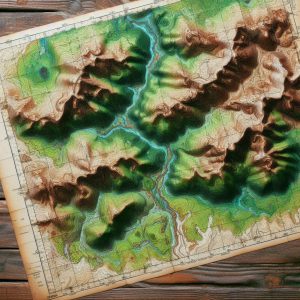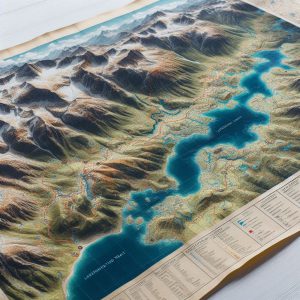Unlock the Secrets of Wilderness Navigation: Develop Skills Beyond GPS
Embarking on the adventure of mastering wilderness navigation without relying on modern technological tools can seem daunting at first. However, honing essential map and compass navigation skills is a life-changing journey that greatly enhances your outdoor experiences. At its core, effective navigation involves a profound understanding of your environment and the capability to locate yourself in relation to your intended destination. A map serves as a detailed two-dimensional representation of the terrain, while a compass provides a dependable method to orient yourself using the cardinal directions: north, south, east, and west. By mastering these fundamental navigational tools, you will cultivate the confidence to explore the wilderness independently, liberated from the constraints of modern technology.
To embark on your navigation journey, start by familiarizing yourself with the various symbols and scales displayed on a map; these elements are pivotal for accurately interpreting the physical landscape. Learning to read contour lines, which indicate changes in elevation, is crucial, as it enables you to identify hills, valleys, and other geographical features that could influence your route. Equally important is achieving proficiency with the compass, which empowers you to navigate successfully in the wilderness without the dependence on GPS devices, allowing for a more enriching and immersive outdoor experience.
The compass needle consistently points toward magnetic north, making it essential to align your map with the actual landscape. To achieve this, hold the compass flat in your hand and rotate the map until the magnetic north on the compass aligns accurately with the map’s north. This vital technique, commonly known as “orienting the map,” is fundamental for maintaining accuracy in your navigation efforts and ensuring that you stay on the correct path throughout your adventure.
Once you successfully orient your map, you can use the compass to take bearings that will guide your journey. By effectively integrating these two powerful navigational tools—the map and the compass—you will confidently navigate through unfamiliar terrains, ensuring that you remain on track even in the absence of modern technological support.
Key Strategies for Effective Outdoor Navigation Mastery
- Mastering map and compass navigation is essential for anyone participating in wilderness exploration or outdoor activities, empowering them to traverse nature confidently.
- Topographic maps offer intricate insights into the terrain, elevation changes, and natural features, which are critical for successful navigation.
- A compass not only helps indicate direction but also aids in effective navigation by aligning with the map’s orientation and understanding magnetic north.
- Natural landmarks and clues, such as distinctive rock formations or unique tree patterns, can serve as invaluable navigational aids when traditional tools are unavailable.
- Estimating distance and travel time is vital for planning and executing a successful navigation strategy in the wilderness, ensuring preparedness for the journey ahead.
 The Essential Importance of Topographic Maps in Wilderness Navigation
The Essential Importance of Topographic Maps in Wilderness Navigation
Topographic maps are invaluable resources for anyone eager to explore the wilderness. These maps are rich with information about the physical characteristics of the terrain, utilizing contour lines to illustrate changes in elevation and allowing you to visualize the landscape’s shape and steepness. Understanding these contours equips you with critical knowledge for anticipating the challenges you may encounter on your journey. Each contour line connects points of equal elevation, and the spacing between these lines reveals the steepness of slopes, providing you with essential insights for effective navigation.
Understanding Contour Lines and Map Symbols for Enhanced Navigation
As you study a topographic map, it’s crucial to carefully analyze the patterns created by contour lines; closely spaced lines indicate steep terrain, while widely spaced lines signify flatter areas. This understanding will empower you to anticipate potential obstacles along your route, allowing for well-informed navigation decisions. Furthermore, topographic maps are filled with symbols that represent various landmarks, including rivers, roads, trails, and diverse types of vegetation. Familiarizing yourself with these symbols is essential for successful navigation, ensuring you can effectively utilize the map during your journey.
Applying Navigation Techniques with Topographic Maps for Success
For instance, blue lines typically signify the presence of water bodies such as streams or lakes, while green areas may indicate forests or dense vegetation. By cross-referencing these symbols with your physical surroundings, you can verify your location and adjust your route as necessary. Additionally, topographic maps often contain grid lines that assist in pinpointing coordinates, allowing for even greater precision in navigation. By mastering the intricacies of topographic maps, you will enhance your appreciation for the landscape while significantly improving your overall navigational skills in the wilderness.
 Leveraging Compass Techniques for Accurate Directional Navigation
Leveraging Compass Techniques for Accurate Directional Navigation
A compass is an essential instrument for any adventurer, functioning as an invaluable tool for directional navigation, particularly in unfamiliar landscapes. To utilize a compass effectively, start by holding it level in front of you and allowing the needle to stabilize. The needle points toward magnetic north, which can slightly differ from true north due to magnetic declination—the angle between magnetic north and true north varies based on your geographical location and is crucial for accurate navigation.
Before embarking on your journey, it is vital to determine the local declination and adjust your compass accordingly. This adjustment ensures that your bearings remain precise, assisting you in maintaining course throughout your adventure. Once your compass is calibrated for declination, you can proceed to take a bearing that will guide your direction of travel effectively.
To take a bearing, identify a landmark you wish to navigate toward and rotate the compass housing until the orienting arrow aligns with the magnetic needle. The degree reading on the compass dial that aligns with the index line indicates your bearing. As you progress toward your destination, it is advisable to periodically check your bearing to confirm that you are staying on your intended course.
If you find yourself drifting off course, reorient your compass and adjust your path as necessary. By mastering these techniques, you will develop the confidence to rely on a compass as a trustworthy navigational tool during any outdoor excursion.
 Utilizing Natural Landmarks and Clues for Enhanced Navigational Skills
Utilizing Natural Landmarks and Clues for Enhanced Navigational Skills
While maps and compasses are essential navigational tools, keenly observing natural landmarks and signs can significantly elevate your ability to navigate the wilderness effectively. Unique features such as mountains, rivers, or distinctive trees can serve as invaluable reference points when traversing unfamiliar terrain. For instance, if you know a specific mountain is located to the east of your starting point, you can use it as a guiding reference to ensure you are traveling in the correct direction.
Additionally, familiarizing yourself with the unique characteristics of your environment aids in creating mental maps that enable navigation without solely depending on tools. In addition to prominent landmarks, pay attention to natural signs that can indicate direction or shifts in terrain. The sun’s position can act as a helpful indicator; in the northern hemisphere, the sun rises in the east and sets in the west, providing a general sense of direction throughout the day.
Moreover, observing the growth patterns of moss on trees—often denser on the north side—can provide valuable clues about orientation in dense forests. Animal trails can also serve as directional hints; many animals follow established paths that can lead you toward water sources or other significant landmarks. By refining your ability to interpret these natural signs, you will become increasingly adept at navigating through various environments.
Mastering Distance Estimation and Travel Time Calculation for Effective Navigation
Accurately estimating distance and travel time is vital for effective navigation in wilderness areas. Understanding how far you have traveled and how long it will take to reach your destination allows for improved planning and helps you avoid unexpected obstacles. One practical technique for estimating distance involves pacing—counting your steps as you walk.
On average, an adult’s stride measures approximately 2.5 feet, which means that by counting your steps over a known distance, you can gauge how far you’ve traveled based on your pace. Additionally, consider the type of terrain and elevation changes when calculating travel time. For instance, traversing flat ground typically allows for quicker movement compared to navigating steep hills or rocky paths.
A common guideline suggests estimating that you can cover roughly three miles per hour on flat terrain; however, this estimate should be significantly adjusted when faced with challenging landscapes. By taking these variables into account and adapting your expectations accordingly, you will be better prepared for your journey and more capable of managing your time effectively throughout your outdoor expedition.
Designing a Strategic Wilderness Route and Navigation Plan for Success
Crafting a Detailed Wilderness Route Plan for Effective Navigation
Creating an effective navigation plan is crucial before embarking on any wilderness adventure. Begin by studying topographic maps of the area you intend to explore, identifying potential routes based on notable landmarks, existing trails, and accessible water sources. As you outline your route, consider factors such as elevation changes and the terrain’s difficulty level; ensuring your plan is both realistic and achievable is of utmost importance for a safe journey.
Preparing for Unexpected Obstacles and Environmental Changes During Your Journey
While planning your route, it is wise to consider alternative paths in case you encounter unexpected obstructions or sudden weather changes. Having multiple options available will provide you with greater flexibility during your journey and contribute to your safety. This adaptability is crucial for a successful and enjoyable wilderness experience, enabling you to navigate challenges that may arise with ease and confidence.
Developing a Comprehensive Navigation Strategy for Wilderness Adventures
After mapping out potential routes, create a detailed navigation plan that includes critical waypoints. Mark these waypoints on your map and, if feasible, record their coordinates, enabling you to monitor your progress as you navigate through the wilderness. Additionally, factor in estimated travel time between waypoints and identify any potential hazards you may encounter along your chosen route. This thorough preparation will enhance your overall navigation experience.
Ensuring a Safe and Rewarding Outdoor Experience Through Thorough Planning
Thorough planning and anticipation of challenges will significantly enhance your chances of reaching your destination while enjoying a safe and fulfilling outdoor experience. A well-structured navigation strategy is vital for a successful wilderness adventure, ensuring that you can explore the great outdoors with confidence and assurance, knowing you are well-prepared for whatever lies ahead.
 Implementing Emergency Navigation Techniques for Unforeseen Scenarios
Implementing Emergency Navigation Techniques for Unforeseen Scenarios
Even with meticulous planning and preparation, unforeseen circumstances may arise during outdoor adventures that necessitate emergency navigation techniques. One essential skill is the ability to backtrack; if you find yourself lost or disoriented, retracing your steps can often lead you back to familiar territory. To execute this effectively, pay close attention to distinctive landmarks or features along your route, which can serve as reference points when returning to safety.
Another invaluable technique is celestial navigation, particularly useful when visibility permits—especially on clear nights or sunny days when stars or celestial bodies are visible. Familiarizing yourself with prominent constellations, such as the North Star (Polaris) in the northern hemisphere, can guide you, as it remains relatively fixed in position while other stars shift. By locating Polaris and determining its angle above the horizon, you can ascertain true north, even without a compass or map.
If you have a watch or smartphone as a backup, utilizing it alongside celestial navigation can reinforce your sense of direction during emergencies, helping you maintain your orientation even in challenging situations. This approach allows you to navigate confidently, ensuring that you can find your way even when circumstances are less than ideal.
Enhancing Your Wilderness Navigation Skills: Practical Strategies for Improvement
Improving your wilderness navigation skills requires dedication and practice, but the rewards can significantly enrich your outdoor adventures. One effective approach is to join local hiking groups or outdoor clubs, where members can share their knowledge and experiences regarding navigation techniques. Engaging with seasoned navigators can provide invaluable insights into best practices while offering hands-on learning opportunities across diverse terrains, enhancing your learning experience.
Another beneficial strategy involves regularly practicing with maps and compasses in various environments—whether in urban settings or remote wilderness areas—to build your confidence in these skills. Allocate time for solo excursions where you intentionally navigate without the aid of technology; this practice will reinforce your abilities while fostering a deeper connection with nature. Furthermore, consider maintaining a navigation journal to document routes taken, challenges faced, and lessons learned during each adventure; this reflective practice will enhance your skills and deepen your appreciation for navigating diverse landscapes.
By embracing these techniques and continually refining your skills in map reading, compass usage, natural observation, distance estimation, route planning, emergency strategies, and sharing practical experiences with others, you will evolve into a more self-assured navigator, capable of thriving in any wilderness environment, even without the support of technology.
Your Questions Answered: Common FAQs About Wilderness Navigation Techniques
What does wilderness navigation entail?
Wilderness navigation encompasses the skills necessary to determine and maintain a route through natural, often remote, and undeveloped areas. It involves employing various tools and techniques to stay on course and safely reach a desired destination without reliance on modern technology.
What traditional methods are utilized in wilderness navigation?
Traditional methods of wilderness navigation include using a map and compass, interpreting topographic features, observing natural landmarks, and employing celestial navigation techniques based on the sun, moon, and stars, enhancing your ability to navigate effectively.
Why might someone choose to navigate without GPS technology?
Many individuals opt to navigate without GPS for a variety of reasons, including the desire to enhance their wilderness navigation skills, embrace the challenge of traditional methods, or prepare for potential GPS failures or limited access to technology during their adventures.
What advantages does learning wilderness navigation without GPS provide?
Learning wilderness navigation techniques without GPS can deepen one’s understanding of the natural environment, increase self-reliance and confidence, and provide a backup plan in case of technology failures or limited access to GPS devices during critical moments.
What challenges may arise when navigating in the wilderness without GPS support?
Challenges associated with wilderness navigation without GPS include the need for advanced planning, the potential for human error, and reliance on environmental conditions such as weather and visibility, all of which require careful consideration when preparing for an outdoor adventure.
The post Wilderness Navigation Techniques Without GPS appeared first on Survival Bite.
The Article Wilderness Navigation Techniques for Off-Grid Adventures Was Found On https://limitsofstrategy.com







The idea of mastering wilderness navigation without relying on GPS really resonates with me. A few summers ago, I decided to hike a remote trail in the Pacific Northwest, and while I had packed all my modern gadgets, I realized soon into my journey that I had become overly dependent on them. The second I lost signal, I started to feel a bit panicked, which was such a stark contrast to the sense of freedom I thought I’d feel in nature.
Your exploration of wilderness navigation beyond GPS resonates deeply with me, as it’s a skill set that can reframe how we interact with the natural world. For many of us, there’s a certain comfort in relying on our phones for navigation, but I believe there’s something incredibly enriching about getting in touch with traditional navigation methods — a connection to our surroundings that technology often obscures.
I completely agree with your perspective on wilderness navigation and the connection it fosters with our surroundings. There’s something profoundly grounding about stepping away from the digital interface and engaging directly with the landscape. When I first learned traditional navigation skills—like reading topographic maps and using a compass—I was surprised by how much more aware I became of my environment. It’s like a completely different lens through which to view the world.